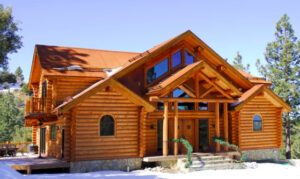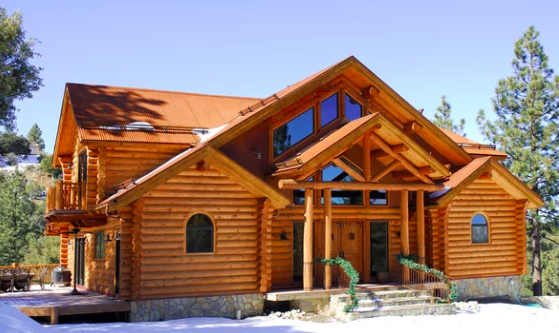Moisture is one of the greatest threats to log homes. It can cause mold and mildew as well as rot. A few preventative measures can help minimize moisture damage to your log home. Start with the basics, such as washing the exterior regularly. This removes surface contaminants like dirt, pollen, dust, and bird droppings. For more information, you can contact Richardson Log Homes LLC.
Inspect the Roof
 Unlike many other types of houses, log homes often have very steep roofs. This is a good thing because it helps protect the wood from moisture problems. However, it can create challenges when water runs off the top and splashes onto lower logs or the deck below. This can cause serious rot and insect infestations.
Unlike many other types of houses, log homes often have very steep roofs. This is a good thing because it helps protect the wood from moisture problems. However, it can create challenges when water runs off the top and splashes onto lower logs or the deck below. This can cause serious rot and insect infestations.
One way to help prevent this is to ensure that there are adequate overhangs on all of the roof areas. This will help prevent water from directly hitting the logs, and also make it easier to clean. In addition, you want to make sure there are no tree limbs that are touching the roof. This can create moisture issues and lead to a build-up of mold.
If you are buying an older home it is a good idea to have a professional inspection done by someone that has experience with log homes. This will help you recognize potential problems and be able to negotiate properly.
During the home inspection look for humps and valleys, roof material, flashing condition, and seals around chimneys and vents. Make sure that the gutters are not clogged and that down spouts are working properly.
Another thing to check for is a dark stain that looks like black surface fungus. This is a sign of rot and needs to be eradicated before staining. Look for a darker color on the log ends as well, this indicates that they have been exposed to the elements and should be treated with Shell-Guard before staining.
You should also look for any cracks in the logs. Small cracks are normal and not a big deal, but large ones should be inspected carefully by a specialist. It is also a good idea to look for signs of carpenter bees and ants in the area. They will leave little piles of sawdust, which you can identify by putting some masking tape over the spots and checking them a few days later. If you see any of this, have a pest control specialist come out and do an inspection and treatment.
Inspect the Walls
Log homes are vulnerable to moisture and rain because they do not have the same protection that frame houses have. They need to be properly flashed and drained to prevent water saturating the logs which can lead to rot. It is also important to examine the logs for rot, cracking, checking or other signs of dampness. Often this can be corrected by chiseling out the rotten areas and treating with a wood preservative. It is also a good idea to have any logs that are showing sign of mildew or mold removed and stained.
Inside the home, check for light and air infiltration between logs as well as leaking windows, doors and their frames. It is also a good idea to hose down the walls, studs and other framing. This helps to lift dirt and microorganisms that can damage the wood over time.
On the outside of the house, look for: clogged gutters and downspouts, erosion or loss areas around the logs, splashback from eaves or roof overhangs. In addition, check that the roof rafters, purlins and ridge beam are not exposed to the weather. It is important to inspect the chinking and caulking in general for: cracking, loosening or peeling, signs of dampness or mold, popped knots and faded stain.
In addition, if the logs are not protected with a good quality log finish, it is recommended that they be media blasted and restained every three years to protect against rot, weathering, insect infestation and mold. This is best done by professionals who can handle the equipment required for this process.
Moisture is the biggest natural hazard to log homes. It can enter through clogged drains and downspouts, overgrown vegetation and improperly built foundations. It can also be caused by untreated logs or poor construction methods.
Fortunately, this is easy to avoid by implementing a good maintenance plan. It starts with the roof and continues with the logs, girders and other structural components of the home. Then, by maintaining proper drainage, insulating and properly staining, the logs will last for many generations to come.
Inspect the Gutters
When you walk around the outside of your log home, take some time to check that gutters are not clogged with leaves. Having them clogged can cause water to be directed at the logs rather than away from them. This can result in rot and damage.
Also, look for any leaking windows or doors. Even if it is only a small drip, this can add up and cost you in the long run. Checking weather stripping can also be beneficial as this is another area that can leak and let cold air in and bugs out.
Moisture control is critical in log homes as they tend to absorb moisture quickly. This can lead to problems like rot and insect infestations. A proper waterproofing and insecticide treatment applied to the logs can help protect them. Proper drainage plains, high quality gutters and down spouts and roof overhangs are also critical in keeping moisture away from the logs.
Look at the bottom courses of logs (a good builder will have a 3 foot roof overhang to keep moisture away from these lower courses) to make sure they are not damp and for any signs of rot or insect infestation.
Usually, any check or crack that is over 1/4″ wide can be filled and caulked easily. However, if they are left unattended this can allow water to get into the logs which leads to rot and darkening. This can be very expensive to repair.
In addition, if there are any areas that have been painted over with a latex paint, this should be stripped and repainted to avoid any potential issues. Checking for latex paint is important in any home, but is especially critical in a log cabin where it can lead to premature failure and costly repairs.
Finally, check all landscaping to make sure that nothing is touching or near the logs. Plants like ivy or creeping thyme that grow close to the house can cause serious damage and should be pulled or removed. Also, any brush that is close to the logs can create a path of travel for insects and should be removed or trimmed back.
Inspect the Exterior
Once the weather starts to warm up it is time to walk around your cabin exterior and check it over. This is a good opportunity to make sure that the logs have not started to lean or rot in any area, and that the exterior finish has not started to fade or peel. It is important to walk the full perimeter of your cabin, looking for areas where the wood may be exposed or rotting, such as porches and decks, where logs touch each other and where the home meets the roof (rafters, purlins, and ridge beam). Look for signs of insects in the logs. Also, look for black spots on the logs where water has soaked into the wood and left decay and mold or mildew behind. Check caulking. It is important that the caulking in a log home remain tight. Old caulking can shrink and allow air infiltration as well as bugs to enter the home. Check window and door bucks as well as the butt joints for loose caulking, especially in upward-facing checks that can collect rain and dirt.
Checking for settling is important in any handcrafted log home. If the logs start to settle they will pull apart and allow water to get into the interior walls. This can cause problems with doors and windows that were built with settling space above them, as well as damage to stairways and conventionally-framed partition walls. It can also cause issues with plumbing and electrical systems in a log home, as rigid pipes and conduits are not designed to withstand the pressure of shifting logs.
A good inspector will be able to detect these problems before they become serious and recommend corrective action. Make sure that the home inspector you hire has experience with examining log homes. Many general home inspectors do not have the expertise necessary to properly inspect a log structure and recommend the correct corrections. You can find a qualified log home inspector by using the Log Home Professionals Directory.

